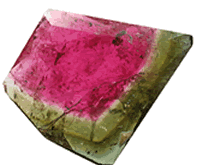
Tourmaline ranges in color from black or white to vibrant shades of red, green, and blue. The color of the best Maine tourmalines rival tourmaline from world-famous localities in California, Brazil, and the Himalayas. Individual crystals range from opaque to transparent and may be single or multi-colored. There is even a "watermelon" variety with a green outer layer surrounding a pink core.
Tourmaline is actually a group of several different minerals which have similar crystal structures, but complex and variable chemical formulas. The exact species of tourmaline is determined by the number of elements present. The most common species in Maine is schorl, a black, iron-bearing tourmaline. The colorful, but less common, species found in Maine is elbaite, named after the island of Elba, Italy. Tourmaline occurs as lustrous, elongate crystals which commonly have a rounded triangular cross section and narrow grooves running parallel to their long direction. The crystals range in size from microscopic to over a foot long. The best examples in Maine are found in a very coarse-grained type of granite called "pegmatite". The slow cooling and solidification of the pegmatite veins allowed the mineral grains to grow to much larger sizes than in ordinary granite. The black tourmaline crystals and many of the brightly colored ones are usually encased in the surrounding rock. However, conditions in some places favored the development of open cavities in which elbaite crystals grew with greater perfection and clarity. These pegmatite "pockets" are the source of Maine's finest gem tourmalines.